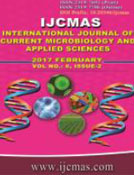


 National Academy of Agricultural Sciences (NAAS)
National Academy of Agricultural Sciences (NAAS)

|
PRINT ISSN : 2319-7692
Online ISSN : 2319-7706 Issues : 12 per year Publisher : Excellent Publishers Email : editorijcmas@gmail.com / submit@ijcmas.com Editor-in-chief: Dr.M.Prakash Index Copernicus ICV 2018: 95.39 NAAS RATING 2020: 5.38 |
The productivity of apple in Jammu and Kashmir is 8.57 metric tons per hectare, when it is compared with the productivity of developed nations of the world this figure is very low and there is plenty of difference in the productivity. In order to curtail this gap a number of factors has to be reviewed seriously and address them priority wise. The factors of prime importance were identified as compatibility of pollen in apple orchards that actually determines the productivity of this most important fruit crop known as king of temperate fruits. The State Horticulture Department (SHD) has introduced some of the Washington based varieties in the valley to overcome the problem of monoculture of delicious group of varieties. This SHD is supplying planting material of these varieties to the farming community without knowing their pollination status. In this regard division of fruit science SKUAST-K has conducted a research programme during 2012 and 2013 on “Blooming behavior of exotic apple cultivars under north Himalayan region of India” to identify the varieties which bloom early, or mid-season blooming varieties and last to bloom and are compatible with each other. Observation were made to evaluate the difference in response of these Washington brought genotypes under valley conditions and their fruitfulness for horticulture industry of Kashmir. During the studies 1st set of varieties Red Gravenstein, Braeburn and Ginger Gold recorded early pink bud (29.61, 30.28 and 30.38 DARD), initial bloom (35.19, 36.74 and 36.69 DARD), end of flowering (49.23, 50.59 and 49.74 DARD) and petal fall (44.83, 46.90 and 46.44 DARD) respectively. The 2nd set of genotypes Gala Must, Royal Gala, Scarlet Spur, Oregon Spur, Golden Delicious and Red Gold noticed pink bud, initial bloom, end of flowering and petal fall after 1st set. The 3rd set of cultivars Law Red Rome and Early Red One were found to show these stages later than earlier sets.
 |
 |
 |
 |
 |